That would at least be our address if we were on the “extended” Manhattan Street Grid, according to this website.

Just goes to show that everything is relative.
Middle and High School … from a Montessori Point of View
That would at least be our address if we were on the “extended” Manhattan Street Grid, according to this website.

Just goes to show that everything is relative.
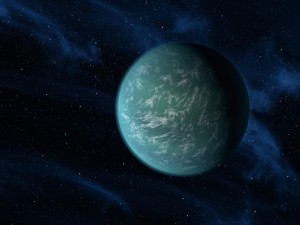
The Voyager 1 spacecraft is rapidly approaching the space between the stars, where the Sun’s solar wind is pushed back by the interstellar magnetic cloud.
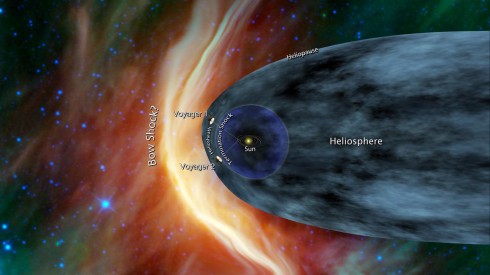
How far will it go? The spacecraft have enough power to last until 2020, when it will be about 20 billion kilometers from the Sun (it’s now about 17.8 billion km away). In 40,000 years it will drift “within 1.6 light years … of AC+79 3888, a star in the constellation of Camelopardalis” that’s about 17.6 light years away.
Consider the 40,000 years it will take Voyager to travel 17.6 light years, and the distance to Keppler 22-b, a recently discovered “Earth-like” planet that’s about 600 light years away.

Keppler 22-b is in the liquid water zone of it’s solar system: far enough away from its sun that water on its surface will not just boil away from the heat, yet close enough that the water does not just freeze solid instead. Liquid water is a key necessity for all life as we know it.
Gum is an effective booster of mental performance, conferring all sorts of benefits without any side effects. … chewing gum is often a better test aid than caffeine. [However] gum chewers only showed an increase in performance during the first 20 minutes of testing.
— Lehrer, 2011: The Cognitive Benefits of Chewing Gum in Wired.
Jonah Lehrer has a fascinating article on, how chewing gum improves mental performance“. It does not seem to matter what type of gum, just as long as you’re chewing.
The benefits (briefly and probably overly simplified) of chewing gum:
On the other hand, while chewing might be good for most types of memory, one study found that chewing, and other rhythmic tasks reduces short-term recall of long lists (Kozlov et al., 2011).
Lehrer cites a 2004 review of the research on gum and memory, which describes chewing gum as, “a functional food with function but no food” (Scholey, 2004).
The takehome message for using gum while taking tests:
When taking a test, save the gum for the hardest part, or for those questions when you feel your focus flagging. The gum will help you concentrate, but the help won’t last long.
— Lehrer, 2011: The Cognitive Benefits of Chewing Gum in Wired.

Hydrogen Sulfide:
H2S
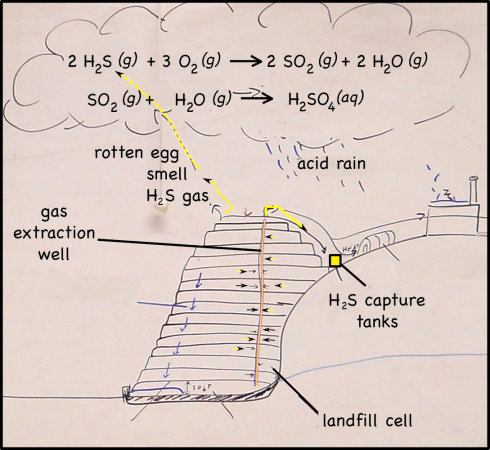
Although it makes up less than 1% of the gases produced by landfills, hydrogen sulfide (H2S) is the major reason landfills smell as bad as they do. H2S is produced by decomposition in the landfill, and if it’s not captured it not only produces a terrible, rotten-egg smell, but also produces acid rain, and, in high enough concentrations, it can be harmful to your health (OSHA, 2005; Ohio Dept. Health, 2010).

Some hydrogen sulfide is produced when organic matter decays, but for big landfills like the one we visited, construction materials, especially gypsum wallboard (drywall), are probably the biggest source.
Gypsum is a calcium sulphate mineral, that’s made into sheets of drywall that are used cover the walls in most houses because it’s easy to work with and retards fire. The U.S. used 17 million tons of gypsum for drywall in 2010 according to the USGS’s Mineral Commodity Summary (USGS, 2011 (pdf)).
Gypsum:
CaSO4•2(H2O)
As you can see from the chemical formula, each gypsum molecule has two water molecules attached. In a fire, the heat required to evaporate the water keeps the temperature of the walls down to only 100 degrees Celcius until the water has evaporated out of the gypsum board.
A number of landfills have banned drywall because it produces so much hydrogen sulfide, but the one we visited still takes it. It’s big enough that they capture the landfill gasses, including the hydrogen sulfide, and then separate it from the other, more useful gasses, like methane, which can be burned to produce heat energy. H2S can also be burned, but they you end up contributing to acid rain.
When hydrogen sulfide reacts with oxygen in the atmosphere it produces sulfur dioxide.
2 H2S (g) + 3 O2 (g) —-> 2 SO2 (g) + 2 H2O (g)
Sulfur dioxide, in turn, reacts with water droplets in clouds to create sulfuric acid.
SO2 (g) + H2O (g) —-> H2SO4 (aq)
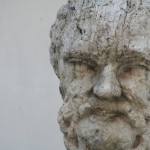
When those droplets eventually coalesce into raindrops, they will be what we call acid rain.
Acid rain damages ecosystems and dissolves statues. It used to be a major problem in the midwestern and eastern United States, but in 1995 the EPA started a cap and trade program for sulfur dioxide emissions (remember sulfur dioxide is produced by burning hydrogen sulfide) that has made a huge difference.

Probably because of the EPA’s restrictions, the landfill company pipes all the gases it collects through scrubbers to extract the hydrogen sulfide. There are a few ways to capture H2S, they all involve running the gas through a tank of some sort of scavenging system that holds a chemical that will react with hydrogen sulfide and not the other landfill gases. At the landfill we visited the remaining landfill gas, which consisted of mostly methane, was used for its energy.
The Missouri Council of Teachers of Mathematics (MoCTM) has a Math & Art Contest that focuses on Geometry. It has fairly simple expectations, and it’s aimed at Middle School students and lower. The tie between the math and the art does not require much depth, but that’s probably appropriate for students who are still developing abstract thinking.
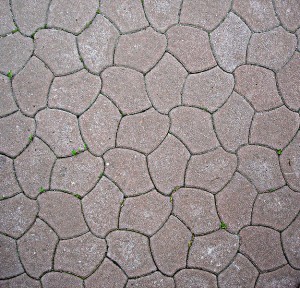
I’m usually a bit cautious about the utility of contests. Their primary benefit is in the work that they motivate, not the reward (or hope of a reward) at the end; although, students do need to learn to win or lose with equanimity.
Spring has gone in the meadow
spring has gone in the flowers
spring has gone in the trees
and winter is comingIt is fall
with leaves to wrestle
and sticks to fall
for spring has goneAnd there are many things to pick
to harvest the apple trees in the orchard
to harvest the paint berries
to harvest the vines
so there are many things that must come to passThere are many things to end
many things to fall
winter lies ahead.– by Maren